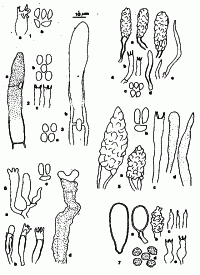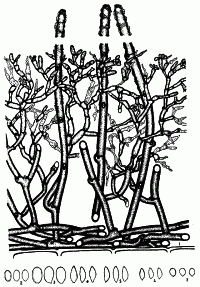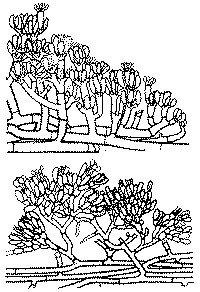|
 Botryobasidium pruinatum Botryobasidium pruinatum
SynonymsPellicularia pruinata
Pellicularia scabrida
Corticium pruinatum
BiostatusPresent in region - Indigenous. Non endemic
Images (click to enlarge)
Caption: Fig. 1-7 Fig. 1 Pellicularia scarbida (PDD 11295). a: basidium, b: spores. Fig. 2
Gyrophanopsis polonensis (KH: 4274), a: cystidium, b: spores, c basidia. Fig. 3 Pellicularia
zealandica (PDD 11449), a: spores, b: cystidium. | 
Caption: FIG. 1. Section through the hymenophore of Pellicularia zealandica. x 750.
FIG. 2. Spores of Pellicularia zealandica.
FIG. 3. Spores of Pellicularia filamentosa.
FIG. 4. Spores of Pellicularia scabrida.
Caption: FIG. 1. Section through the hymenophore of Pellicularia scabrida. Section was taken from
the periphery to show method of branching of the fertile hyphae.
FIG. 2. Section through the hymenophore of Pellicularia filamentosa.
Bot | |
Article: Stalpers, J.A.; Buchanan, P.K. (1991). Type studies of the species of Pellicularia and Peniophora described by G.H. Cunningham. New Zealand Journal of Botany 29(3): 331-340 (http://www.rsnz.org/publish/abstracts.php).
Description: Subicular hyphae hyaline to yellowish, thin- to thick walled (up to 2.5 µm), finely asperulate,
10-18 µm wide. Subhymenial hyphae hyaline, thin-walled, 6-12 µm wide, cyanophilous. Basidia
collapsed. Spores hyaline, smooth, ovoid from above, navicular in side view, 5.5-7.5 x 2.8-3.5 x 3-4
µm, somewhat thick-walled with prominent apiculus.
Notes: The species is indistinguishable from Botryobasidum pruinatum. The spore size is much smaller
than Cunningham's (1953) measurements (8-11 x 3.5-4.5 µm). The basal hyphae are somewhat less
thick-walled, paler and more finely asperulate than typical European'specimens, but these differences
are herein considered to be within the natural variation of the species.
Article: Cunningham, G.H. (1953). Thelephoraceae of New Zealand. Part II: the genus Pellicularia. Transactions of the Royal Society of New Zealand 81(3): 321-328.
Description: Hymenophore annual, loosely attached, lifting, arachnoid-mucedinoid, forming linear areas to
24 x 3 cm.; surface cream, drying pallid ochre, even; margin thinning out, cream, arachnoid.
Context composed of a few large repent hyphae to 16 µ diameter, wall 0.5-1 µ thick,
delicately and finely verruculose-scabrid, sparsely branched, septate, without clamp
connections, fertile hyphae vertical, bearing one to three whorls of branchlets carrying basidia
and paraphyses. Basidia cylindrical or subclavate, 16-22 x 6-9 µ, bearing 4-6 spores on short
sterigmata 3-4 µ long. Spores fusiform or navicular, ends usually bluntly acuminate,
apiculate, 8-11 x 3.5-4.5 µ, smooth, hyaline.
Habitat: HABITAT. Effused on bark or decorticated decaying wood.
Distribution: DISTRIBUTION. New Zealand.
Notes: Of the species without clamp connections this may be identified readily by the large diameter
repent hyphae, walls of which and of the fertile branches are covered with closely arranged
verrucae, appearing scabrid. Basidia are carried on short branchlets arranged in whorls on
main vertical branches. Basidia usually bear six spores, though a few carry four.
|